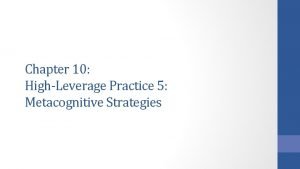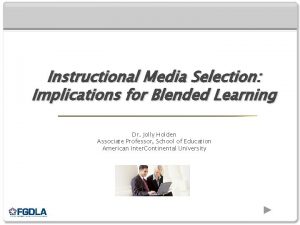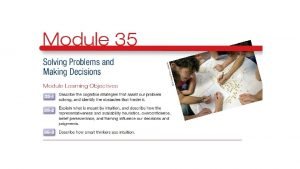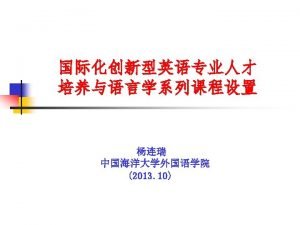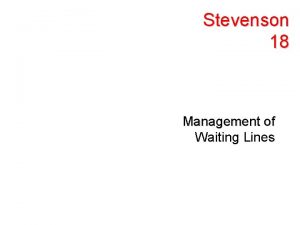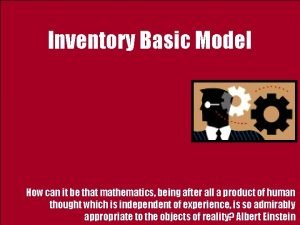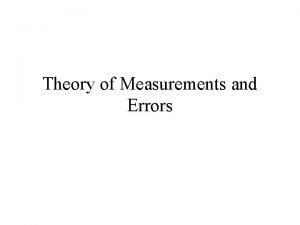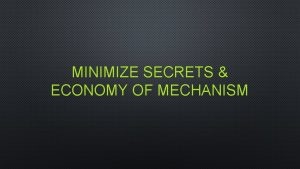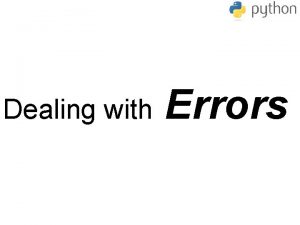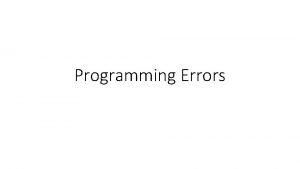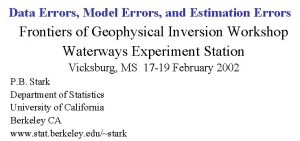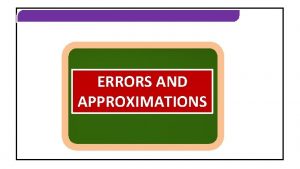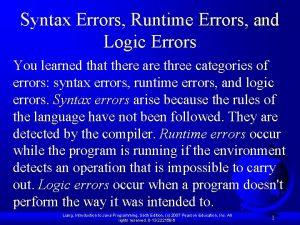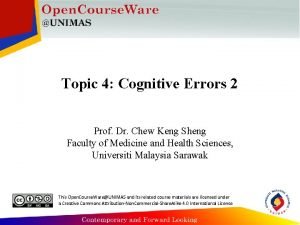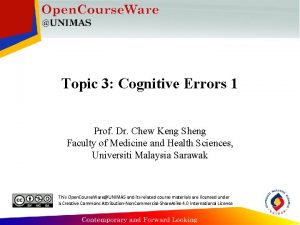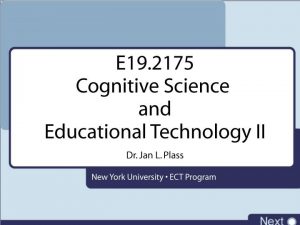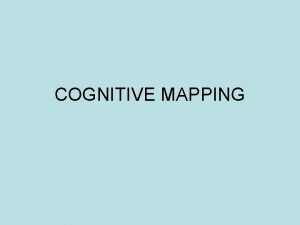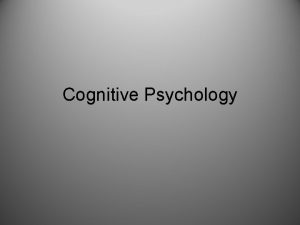Topic 5 Strategies to minimize cognitive errors Prof
















![Types of cognitive load [element interactivity] Intrinsic cognitive load [instructional design] Extraneous cognitive load Types of cognitive load [element interactivity] Intrinsic cognitive load [instructional design] Extraneous cognitive load](https://slidetodoc.com/presentation_image/2bc54de5f83489380863a0c8337fe54e/image-17.jpg)


- Slides: 19

Topic 5: Strategies to minimize cognitive errors Prof. Dr. Chew Keng Sheng Faculty of Medicine and Health Sciences, Universiti Malaysia Sarawak This Open. Course. Ware@UNIMAS and its related course materials are licensed under a Creative Commons Attribution-Non. Commercial-Share. Alike 4. 0 International License.

Objectives • At the end of this lecture, the learners will be able to 1. Outline the strategies in minimizing cognitive errors 2. Outline the high risk situations that increase our risk of committing cognitive errors 3. Describe metacognition and its importance in monitoring our thinking process 4. Describe the importance of taking the impact of cognitive loads into account in designing strategies to minimize cognitive errors

Strategies to minimize cognitive errors • Universal – Critical thinking training – Dual Process theory training – Cognitive/affective bias training • Generic – Get more information – Be more skeptical – Slow down/reflection – Rule out worst case scenario (ROWS) – Consider the opposite

Strategies to minimize cognitive errors • Specific – Specific cognitive forcing functions – Checklists – Clinical practice guidelines/rules – Mnemonics – Statistical prediction rules – Heuristics (standing rules)

High risk situations for biased reasoning High risk situations Potential biases Was this patient handed off to me Diagnosis momentum, from a previous shift? framing Was the diagnosis suggested to me Premature closure, by the patient, nurse or another framing bias physician? Did I just accept the first diagnosis Anchoring, availability, that came to mind? search satisficing, premature closure Did I consider other organ systems Anchoring, search besides the obvious one? satisficing, premature closure

High risk situations for biased reasoning High risk situations Potential biases Is this a patient I don't like, or like too much, for some reason? Affective biases Have I been interrupted or distracted while evaluating this patient? All biases Am I feeling fatigued right now? All biases Did I sleep poorly last night? All biases Am I cognitively overloaded or over All biases -extended right now?

High risk situations for biased reasoning High risk situations Am I stereotyping this patient? Potential biases Representative bias, affective bias, anchoring, fundamental attribution error, psych out error Have I effectively ruled out mustnot-miss diagnoses? Overconfidence, anchoring, confirmation bias Adapted from Graber: General checklist for AHRQ project

Cognitive De-biasing Strategies Many cognitive debiasing strategies have been proposed and tried (Graber et al. 2012) Many of these strategies take time and slow down the decision making process Graber ML, Kissam S, Payne VL, Meyer AN, Sorensen A, Lenfestey N, et al. Cognitive interventions to reduce diagnostic error: a narrative review. BMJ Qual Saf. 2012; 21(7): 535 -57.

Challenges To Implement Cognitive Debiasing Strategies • The occasions where cognitive debiasing strategies are most needed (i. e. a stressful environment) are often the occasions for which the clinicians can least afford the time and effort to engage in them. • It is theorized that the very strategy of effectively debiasing cognitive biases should be a Type 1 thinking process itself. • The strategy must be easily retrievable, automatized to a large degree

In a chaotic ward (predominantly Type 1 thinking employed) On-going task Interruption 3 Interruption 1 On-going task: coming up with a working diagnosis for Patient A Task-switching Interruption 2 DELAY Task-switching Returning to Patient A Intended task: Debiasing potential cognitive biases Task-switching Chew KS, Durning SJ, van Merrienboer JJ. Teaching metacognition in clinical decision-making using a novel mnemonic checklist: an exploratory study. Singapore Med J 2016; 2016(15): 2016015.

Metacognition • One kind of cognitive debiasing strategies (Graber et al, 2012) • “Meta” = beyond; “thinking about thinking” • Defined as the reflective & analytic practice of deliberately examining one’s thinking process and affective state as well as their effects on clinical decisions (Trowbridge et al, 2013) Trowbridge RL, Dhaliwal G, Cosby KS. Educational agenda for diagnostic error reduction. BMJ Qual Saf 2013; 22 Suppl 2: ii 28 -ii 32.

T-W-E-D Checklist T = Threat (What is the life or limb threat in this patient? ) W = Wrong (What if I am wrong? What else could it be? ) “TWED” E = EVIDENCE D = pre. Dispositional (Do I have sufficient evidences for or exclude this diagnosis? ) Any Environmental & Emotional factors (2 Es) influence? Chew KS, van Merrienboer J, Durning SJ. A portable mnemonic to facilitate checking for cognitive errors. BMC Res Notes 2016 Sep 17; 9(1): 445.

T-W-E-D Checklist Classification (Campbell et al, 2007) T-W-E-D Checklist 2. Failure to consider worst-case scenario T 1. Over attachment to a particular diagnosis W 2. Failure to consider another diagnoses 3. Inheriting someone else’s thinking E 4. Errors in prevalence perception or estimation 5. Errors contributed by patient characteristics or presentation context (“Emotional”) 6. Physician affect or personality (“Emotional”) 7. Impact of environmental factor (“Environmental”) D

Cognitive load • Cognitive load is a multi-dimensional concept describing the load imposed on the cognitive system due to a task performance (Paas & van Merrienboer 1994; Sweller et al, 1998). • It has a task-based dimension as well as a learner-based dimension (Sweller et al, 1998).

Cognitive load • Task-based dimension refers to the mental load imposed by performing a particular task in a particular environment and it is partly dependent on task characteristics such as the novelty of the task as well as the level of element interactivity (Paas & van Merrienboer 1994; Sweller et al, 1998).

Two dimensions of cognitive load Task-based dimension • Mental load imposed in performing a particular task in a particular environment • Dependent on task characteristics (e. g. task novelty) • Element interactivity Learner-based dimension • Mental effort to accommodate the task demand Sweller J, van Merrienboer JJG, Paas FGWC. Cognitive Architecture and Instructional Design. Educational Psychology Review. 1998; 10(3): 251 -96.
![Types of cognitive load element interactivity Intrinsic cognitive load instructional design Extraneous cognitive load Types of cognitive load [element interactivity] Intrinsic cognitive load [instructional design] Extraneous cognitive load](https://slidetodoc.com/presentation_image/2bc54de5f83489380863a0c8337fe54e/image-17.jpg)
Types of cognitive load [element interactivity] Intrinsic cognitive load [instructional design] Extraneous cognitive load [contributes to learning] Germane cognitive load

Working memory • Essential for items pre-stored in long-term memory to be brought into the active working memory for cognitive processing • The capacity of the working memory is limited (Miller 1956; van Merrienboer & Sweller, 2010). • Miller, for example, in his classic paper in 1956, stated that the working memory is capable of holding only about 7 (plus or minus 2) items at a given time (Miller 1956).

Educational Intervention • For an educational intervention to be effective, ensure total cognitive load ( = intrinsic cognitive load + extraneous cognitive load + germane cognitive load) is kept within the capacity of the working memory
 Cognitive and non cognitive religious language
Cognitive and non cognitive religious language Cognitive learning strategies
Cognitive learning strategies 9 cognitive strategies
9 cognitive strategies Definition of cognitive strategies
Definition of cognitive strategies Preemptive message strategy
Preemptive message strategy What cognitive strategies assist our problem solving
What cognitive strategies assist our problem solving Definition of cognitive strategies
Definition of cognitive strategies Bloom's taxonomy synthesis
Bloom's taxonomy synthesis Broad topic and specific topic examples
Broad topic and specific topic examples General topic example
General topic example Minimize perceptual mismatches
Minimize perceptual mismatches The goal of waiting line management is to minimize
The goal of waiting line management is to minimize For internationalizing firms the consequences
For internationalizing firms the consequences Most inventory models attempt to minimize
Most inventory models attempt to minimize Minimize dfa
Minimize dfa Savchgobj
Savchgobj Karnaugh map examples exercises
Karnaugh map examples exercises Minimize dfa
Minimize dfa Example of fundamental attribution error
Example of fundamental attribution error Theory of errors
Theory of errors


